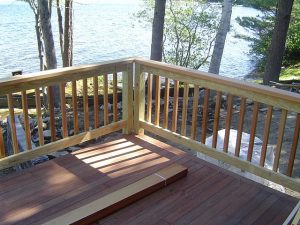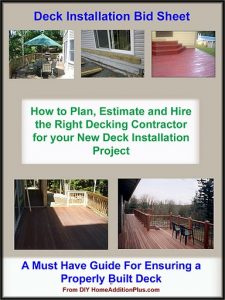Tips on How to Install Deck Boards Properly and How Much Overhang on Deck Boards
By Mark J. Donovan
|
|
After completing the main deck framing comes the task of installing decking boards. Installing deck boards normally begins next to the house wall.
Decking boards are typically installed perpendicular to the floor joists, however in some deck designs they are installed diagonally to the joists. It is important to install decking boards with a sufficient enough gap between boards so that they can expand and contract freely and easily drain water. |
To determine the length of decking boards required, measure the width of the deck from rim joist to rim joist. Make sure to add additional length to this measurement if you plan to have a skirt board over the rim joists.
How Much to Overhang on Deck Boards to Create a Reveal
In addition, you may want to add an additional 1/2 inch to the overall length so that you can create a ¼ inch reveal. The reveal allows the decking boards to overhang the skirt board by ¼ of an inch.
| Cut the first two decking boards to the required length and fasten them down to the deck framing starting near the house wall and making sure they are installed perfectly straight.
Use 12d galvanized decking nails or stainless steel nails/screws for installing decking boards to the deck frame. To prevent splitting you may need to first drill pilot holes in the decking boards. |
 |
Also, make sure to leave a ¼ to ½ inch gap between the house wall and the first decking board to allow water runoff between the deck edge and house wall. In addition, space the decking boards 1/16 to 1/8 inch apart.
If using pressure treated decking boards that are still green and wet space the boards 1/16 inch apart. If the boards are light and dry space the boards 1/8 inch apart. Instead of measuring for the gap when installing each decking board use a 12d or 16d penny nail as a spacer. Learn about using mahogany decking boards here.
| For the remaining boards continue to fasten them down to the deck without cutting them to the measured length.
After installing all the decking boards you will snap a chalk line and trim the remaining wild ends with a skill saw. While installing decking boards make sure to continuously check that they remain parallel to the house wall and first board. If you find the decking boards are walking off on one side adjust the problem over multiple rows versus a single row. |

Use this deck installation checklist and save time and money on your deck project. |
Also, if you have a curved deck board, use a flat-bar to bow it straight before nailing it to the deck frame.
Simply hammer the end of the flat-bar into the nearest deck joist, and use it as a lever to straighten and hold the bowed deck board in place while you nail it down.
|
When installing a decking board around a deck post use a jig saw to cut out the necessary jog in the deck board. Also you may want to add blocking to the deck frame near the deck post to provide a nailing surface for the decking board near the jog. How Much Overhang on Deck Boards When installing the last decking board make sure it overhangs the end rim joist or skirt board by approximately 1 inch to provide a nice reveal. |
|
After installing all the decking boards snap a chalk line on each end of the wild deck board ends. Use your two cut boards as a reference for establishing your chalk line. Finally use a skill saw to trim the ends of the decking boards.
For help on building a deck, see HomeAdditionPlus.com’s Deck Installation Bid Sheet. The Deck Installation Bid Sheet will teach your how to hire the right deck contractor, and help to ensure that your deck project is completed on time and budget.
Related Information
Additional Deck Building and Design Resources
 |
 |
Get Free Deck Building Price Quotes with No Obligation!
Fill out our 3-5 minute quick and easy form, and receive a free price quote on decks from one of our pre-screened and licensed deck contractors. This process is free and there is no obligation to continue once you receive your decks price estimate.
